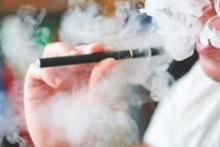Ninth-graders who have used electronic cigarettes are much more likely than are nonusers to try regular cigarettes, cigars, and hookahs during the subsequent year, according to a report published online Aug. 18 in JAMA.
E-cigarettes are handheld battery-operated devices that heat a liquid composed of nicotine, propylene glycol or glycerin, flavorings, and other chemicals to create a vapor that is inhaled, simulating the experience of cigarette smoking. Their main potential benefit is to help adult smokers switch from using the more unhealthy combustible tobacco.
However, critics argue that adolescents who use e-cigarettes may be more likely to try other products that deliver nicotine, which would perpetuate the current epidemic of tobacco-related illness, said Adam M. Leventhal, Ph.D., of the department of preventive medicine, University of Southern California, Los Angeles, and his associates.
The investigators analyzed data from a longitudinal survey of substance use and mental health among high school students. In their prospective observational study, they focused on 2,530 demographically diverse students in ninth grade at 10 Los Angeles–area public high schools. The students were nonsmokers at baseline. A total of 222 of these adolescents reported that they had used e-cigarettes, while 2,308 had not.
Adolescents who had used e-cigarettes were much more likely than were nonusers to report trying combustible tobacco products during the next 6 months (30.7% vs 8.1%) and during the next 12 months (25.2% vs 9.3%), for an odds ratio of 4.27 averaged across the two study periods. This association was strong for each of the combustible tobacco products assessed, with an OR of 2.65 for regular cigarettes, an OR of 4.85 for full-size cigars or cigarillos, and an OR of 3.25 for hookahs.
When the data were adjusted to account for many sociodemographic, environmental, and intrapersonal characteristics known to influence smoking, the ORs declined but the associations remained strong and statistically significant, ranging from 1.75 to 2.96, depending on the smoking product, Dr. Leventhal and his associates said (JAMA. 2015;314[7]:700-707). One possible explanation for these findings is that adolescents who used e-cigarettes enjoyed the experience and were more likely to experiment with other nicotine-containing products. However, “because this is an observational study, and one of the first to address this issue, inferences regarding whether this association is or is not causal cannot yet be made,” they noted.


